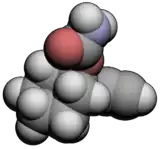Hexapropymate
 | |
 | |
| Clinical data | |
|---|---|
| ATC code | |
| Identifiers | |
IUPAC name
| |
| CAS Number |
|
| PubChem CID | |
| ChemSpider |
|
| UNII | |
| ChEMBL | |
| CompTox Dashboard (EPA) | |
| ECHA InfoCard | 100.006.018 |
| Chemical and physical data | |
| Formula | C10H15NO2 |
| Molar mass | 181.235 g·mol−1 |
| 3D model (JSmol) | |
SMILES
| |
InChI
| |
| | |
Hexapropymate is a hypnotic/sedative. It has effects similar to those of barbiturates and was used in the 1970s-1980s in the treatment of insomnia before being replaced with newer drugs with improved safety profiles.[1]
References
- ↑ Gustafsson LL, Berg A, Magnusson A, Malmlund HO, Sandell BM, Stig R (1989). "Hexapropymate self-poisoning causes severe and long-lasting clinical symptoms". Medical Toxicology and Adverse Drug Experience. 4 (4): 295–301. doi:10.1007/bf03259914. PMID 2770531. S2CID 24560026.
| Alcohols |
|
|---|---|
| Barbiturates |
|
| Benzodiazepines |
|
| Carbamates | |
| Flavonoids |
|
| Imidazoles | |
| Kava constituents |
|
| Monoureides |
|
| Neuroactive steroids |
|
| Nonbenzodiazepines | |
| Phenols | |
| Piperidinediones | |
| Pyrazolopyridines | |
| Quinazolinones | |
| Volatiles/gases |
|
| Others/unsorted |
|
See also: Receptor/signaling modulators • GABA receptor modulators • GABA metabolism/transport modulators | |
This article is issued from Offline. The text is licensed under Creative Commons - Attribution - Sharealike. Additional terms may apply for the media files.